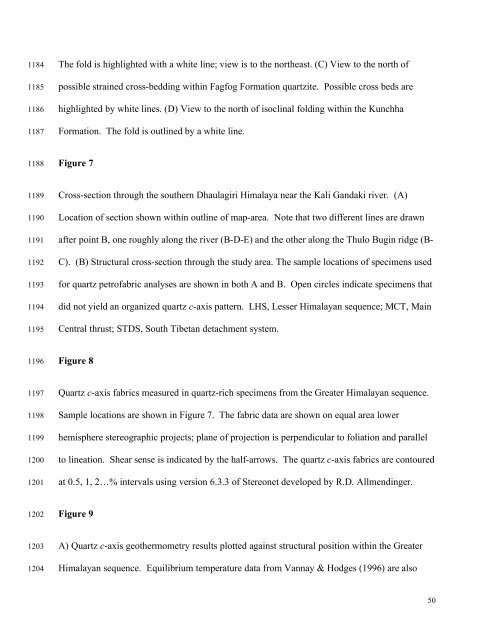Kinematics of the Greater Himalayan sequence, Dhaulagiri Himal ...
Kinematics of the Greater Himalayan sequence, Dhaulagiri Himal ...
Kinematics of the Greater Himalayan sequence, Dhaulagiri Himal ...
Create successful ePaper yourself
Turn your PDF publications into a flip-book with our unique Google optimized e-Paper software.
1184<br />
1185<br />
1186<br />
1187<br />
The fold is highlighted with a white line; view is to <strong>the</strong> nor<strong>the</strong>ast. (C) View to <strong>the</strong> north <strong>of</strong><br />
possible strained cross-bedding within Fagfog Formation quartzite. Possible cross beds are<br />
highlighted by white lines. (D) View to <strong>the</strong> north <strong>of</strong> isoclinal folding within <strong>the</strong> Kunchha<br />
Formation. The fold is outlined by a white line.<br />
1188<br />
Figure 7<br />
1189<br />
1190<br />
1191<br />
1192<br />
1193<br />
1194<br />
1195<br />
Cross-section through <strong>the</strong> sou<strong>the</strong>rn <strong>Dhaulagiri</strong> <strong>Himal</strong>aya near <strong>the</strong> Kali Gandaki river. (A)<br />
Location <strong>of</strong> section shown within outline <strong>of</strong> map-area. Note that two different lines are drawn<br />
after point B, one roughly along <strong>the</strong> river (B-D-E) and <strong>the</strong> o<strong>the</strong>r along <strong>the</strong> Thulo Bugin ridge (B-<br />
C). (B) Structural cross-section through <strong>the</strong> study area. The sample locations <strong>of</strong> specimens used<br />
for quartz petr<strong>of</strong>abric analyses are shown in both A and B. Open circles indicate specimens that<br />
did not yield an organized quartz c-axis pattern. LHS, Lesser <strong><strong>Himal</strong>ayan</strong> <strong>sequence</strong>; MCT, Main<br />
Central thrust; STDS, South Tibetan detachment system.<br />
1196<br />
Figure 8<br />
1197<br />
1198<br />
1199<br />
1200<br />
1201<br />
Quartz c-axis fabrics measured in quartz-rich specimens from <strong>the</strong> <strong>Greater</strong> <strong><strong>Himal</strong>ayan</strong> <strong>sequence</strong>.<br />
Sample locations are shown in Figure 7. The fabric data are shown on equal area lower<br />
hemisphere stereographic projects; plane <strong>of</strong> projection is perpendicular to foliation and parallel<br />
to lineation. Shear sense is indicated by <strong>the</strong> half-arrows. The quartz c-axis fabrics are contoured<br />
at 0.5, 1, 2…% intervals using version 6.3.3 <strong>of</strong> Stereonet developed by R.D. Allmendinger.<br />
1202<br />
Figure 9<br />
1203<br />
1204<br />
A) Quartz c-axis geo<strong>the</strong>rmometry results plotted against structural position within <strong>the</strong> <strong>Greater</strong><br />
<strong><strong>Himal</strong>ayan</strong> <strong>sequence</strong>. Equilibrium temperature data from Vannay & Hodges (1996) are also<br />
50

















